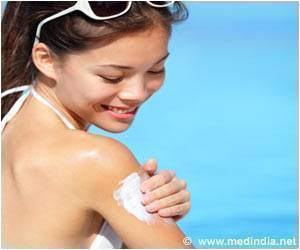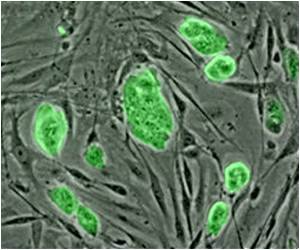Did you know fish have built-in sunscreen? If not, then it is time to discover the mystery of Gadusol.

Gadusol is a maternally provided sunscreen that protects fish embryos from DNA damage
Go to source). This discovery has implications for understanding the ecological and molecular aspects of sun protection in organisms.
As the seasons change and
The laboratory of James Gagnon, a biologist at the University, has been investigating gadusol, a chemical compound found in fish, for many years. Recently, they published a new study that demonstrates how female fish excrete this compound onto their eggs. Gadusol was initially discovered in fish over four decades ago, and it was originally believed to come from their diet. However, subsequent research has proven that fish produce gadusol through metabolic processes within their bodies.
With help from colleagues in the School of Biological Sciences and Department of Human Genetics, doctoral student Marlen Rice is the lead author of the paper published this week. Gagnon, an assistant professor of biology who holds a prestigious Mario Cappecchi Endowed Chair, is listed as the senior author.
Rice grew up on a farm an hour south of Salt Lake City and earned a degree in molecular biology at Utah State University.
“The fun thing to me about biology is just the fact that [living] things are dynamic and they interact [with] their environment,” Rice said. “I like thinking about animals in relation to ecology.”
He aspires to bridge the gap between the ecological and molecular fields. Rice’s lifelong passion for animals and his industry background inspired him to use laboratory tools to investigate ecological factors, starting with sunlight, which sustains all life but also presents a danger.
‘Fish produce a natural sunscreen called ‘Gadusol,’ encoded in their DNA, protecting against sun damage. This has implications for ecological and molecular studies of sun protection. #NaturalSunProtection’





Advertisement
Ultraviolet Exposure Comes at a Cost
Nearly all life on Earth depends on the sun, whether it’s tapping its energy to produce food, or consuming other organisms. But exposure toProtection lies in sunscreens which absorb UV photons before they penetrate vulnerable cells and dissipate this absorbed energy as less harmful heat, according to Rice and Gagnon’s paper. They act as physical shields over precious genetic material in cells, preventing damage and mutations.
Organisms across many habitats have developed adaptations, including nocturnal lifestyles and DNA repair mechanisms, to avoid and fix the harm associated with UV exposure. But some have evolved an ability to create their own chemical sunscreens.
“Since sunlit habitats can have significantly nutritive advantages over dark environments and because no repair pathway is completely efficient, many organisms employ sunscreens to avoid UVR damage from occurring in the first place,” the paper said.
Advertisement
Mutant Zebrafish: a Key to Identifying Natural Sun Protection
Initially, Rice considered melanin as the primary sunscreen in aquatic life. Melanin is produced in melanophores that migrate to cover parts of the brain and body as fish embryos mature.To test this hypothesis, Rice altered the genotype in zebrafish to knock out the gene for melanin production. He found that zebrafish embryos died from UVR exposure at the same rate, regardless of whether or not their genotype was altered. There must be something else protecting the embryos.
Through CRISPR-Cas9 gene editing, Gagnon’s lab created gadusol-deficient mutant zebrafish to test whether gadusol provides UV protection. Zebrafish were chosen for these experiments because they inhabit sunlit waters, produce gadusol, and are amenable to genetic manipulation.
He determined that
Transparency as Camouflage
To demonstrate gadusol’s importance to the survival of larval fish, Rice delivered precise doses of UVB to both the mutant and unaltered zebrafish embryos and measured the effect on swim bladder inflation. When exposed to the same dose, the gadusol-deficient mutant fish were all unable to inflate their swim bladders, indicating that the UV exposure had caused significant developmental defects.A Boston-based beauty company is now looking to synthesize gadusol to create sunscreens that would be safer for both humans and marine environments. For fish, gadusol offers advantages over other sunscreens due to its invisibility. “Transparency as camouflage,” the study said, “is a common trait in aquatic animals, especially in the open ocean where there is nothing to hide behind.”
Melanin’s main drawback is it absorbs most wavelengths in the visible light spectrum as well as the UVB spectrum, so it is detectable by predators. Sunlight, meanwhile, is just one of many challenges that aquatic ecosystems pose to their inhabitants.
“The environment that they evolved in, which is filled with sunlight and viruses and predators and temperature switches and all this crazy stuff that doesn’t happen in our fish facility,” Gagnon said, “and so if you can bring a little bit of that into our laboratory, now we can apply what’s cool to more questions.”
These environmental factors will guide the lab’s research with zebrafish moving forward. Rice is also curious about the evolutionary history of gadusol itself.
“I’d really like to fill out on the tree of life how widespread gadusol is,” Rice said. “At some point, land vertebrates stopped using gadusol. I think evolutionarily it’d be really interesting to think about that. At what point did they move away?”
The answers to these mysteries lie within—within DNA to be specific.
“I really do love the idea of DNA. I think it’s a really beautiful thing,” Rice said, “the fact that it’s an unbroken chain of DNA replication and now lives inside of you.”
Various species, including humans, possess a natural form of sunscreen encoded in their DNA, which provides protection against the harmful effects of ultraviolet rays from the sun.
The research of biologist James Gagnon's lab has focused on gadusol, a chemical compound found in fish, and a recent study reveals how female fish excrete this compound onto their eggs. Gadusol was initially believed to come from the fish's diet, but it has been established that fish produce gadusol through metabolic processes within their bodies (1✔ ✔Trusted Source
Gadusol is a maternally provided sunscreen that protects fish embryos from DNA damage
Go to source). This discovery has implications for understanding the ecological and molecular aspects of sun protection in organisms.
As the seasons change and
The laboratory of James Gagnon, a biologist at the University, has been investigating gadusol, a chemical compound found in fish, for many years. Recently, they published a new study that demonstrates how female fish excrete this compound onto their eggs. Gadusol was initially discovered in fish over four decades ago, and it was originally believed to come from their diet. However, subsequent research has proven that fish produce gadusol through metabolic processes within their bodies.
With help from colleagues in the School of Biological Sciences and Department of Human Genetics, doctoral student Marlen Rice is the lead author of the paper published this week. Gagnon, an assistant professor of biology who holds a prestigious Mario Cappecchi Endowed Chair, is listed as the senior author.
Rice grew up on a farm an hour south of Salt Lake City and earned a degree in molecular biology at Utah State University.
“The fun thing to me about biology is just the fact that [living] things are dynamic and they interact [with] their environment,” Rice said. “I like thinking about animals in relation to ecology.”
He aspires to bridge the gap between the ecological and molecular fields. Rice’s lifelong passion for animals and his industry background inspired him to use laboratory tools to investigate ecological factors, starting with sunlight, which sustains all life but also presents a danger.
Ultraviolet Exposure Comes at a Cost
Nearly all life on Earth depends on the sun, whether it’s tapping its energy to produce food, or consuming other organisms. But exposure toProtection lies in sunscreens which absorb UV photons before they penetrate vulnerable cells and dissipate this absorbed energy as less harmful heat, according to Rice and Gagnon’s paper. They act as physical shields over precious genetic material in cells, preventing damage and mutations.
Organisms across many habitats have developed adaptations, including nocturnal lifestyles and DNA repair mechanisms, to avoid and fix the harm associated with UV exposure. But some have evolved an ability to create their own chemical sunscreens.
“Since sunlit habitats can have significantly nutritive advantages over dark environments and because no repair pathway is completely efficient, many organisms employ sunscreens to avoid UVR damage from occurring in the first place,” the paper said.
Mutant Zebrafish: a Key to Identifying Natural Sun Protection
Initially, Rice considered melanin as the primary sunscreen in aquatic life. Melanin is produced in melanophores that migrate to cover parts of the brain and body as fish embryos mature.To test this hypothesis, Rice altered the genotype in zebrafish to knock out the gene for melanin production. He found that zebrafish embryos died from UVR exposure at the same rate, regardless of whether or not their genotype was altered. There must be something else protecting the embryos.
Through CRISPR-Cas9 gene editing, Gagnon’s lab created gadusol-deficient mutant zebrafish to test whether gadusol provides UV protection. Zebrafish were chosen for these experiments because they inhabit sunlit waters, produce gadusol, and are amenable to genetic manipulation.
He determined that
Transparency as Camouflage
To demonstrate gadusol’s importance to the survival of larval fish, Rice delivered precise doses of UVB to both the mutant and unaltered zebrafish embryos and measured the effect on swim bladder inflation. When exposed to the same dose, the gadusol-deficient mutant fish were all unable to inflate their swim bladders, indicating that the UV exposure had caused significant developmental defects.A Boston-based beauty company is now looking to synthesize gadusol to create sunscreens that would be safer for both humans and marine environments. For fish, gadusol offers advantages over other sunscreens due to its invisibility. “Transparency as camouflage,” the study said, “is a common trait in aquatic animals, especially in the open ocean where there is nothing to hide behind.”
Melanin’s main drawback is it absorbs most wavelengths in the visible light spectrum as well as the UVB spectrum, so it is detectable by predators. Sunlight, meanwhile, is just one of many challenges that aquatic ecosystems pose to their inhabitants.
“The environment that they evolved in, which is filled with sunlight and viruses and predators and temperature switches and all this crazy stuff that doesn’t happen in our fish facility,” Gagnon said, “and so if you can bring a little bit of that into our laboratory, now we can apply what’s cool to more questions.”
These environmental factors will guide the lab’s research with zebrafish moving forward. Rice is also curious about the evolutionary history of gadusol itself.
“I’d really like to fill out on the tree of life how widespread gadusol is,” Rice said. “At some point, land vertebrates stopped using gadusol. I think evolutionarily it’d be really interesting to think about that. At what point did they move away?”
The answers to these mysteries lie within—within DNA to be specific.
“I really do love the idea of DNA. I think it’s a really beautiful thing,” Rice said, “the fact that it’s an unbroken chain of DNA replication and now lives inside of you.”
References:
- Gadusol is a maternally provided sunscreen that protects fish embryos from DNA damage - (https://www.biorxiv.org/content/10.1101/2023.01.30.526370v1.full)
Source-Newswise














